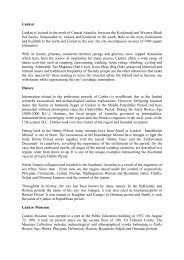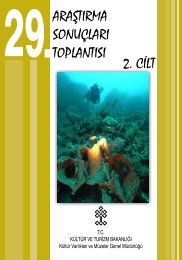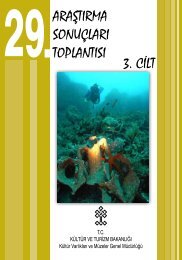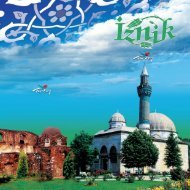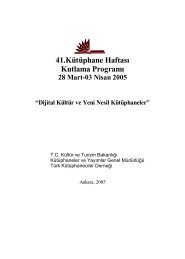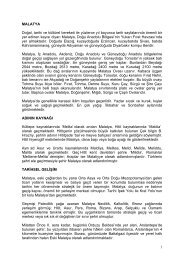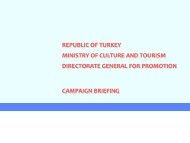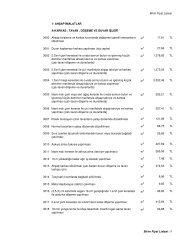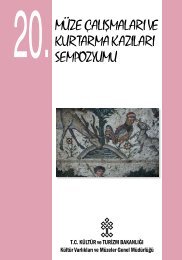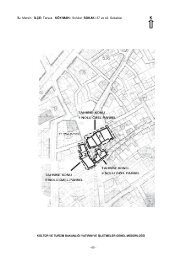Create successful ePaper yourself
Turn your PDF publications into a flip-book with our unique Google optimized e-Paper software.
<strong>Samsun</strong> is a distinctive and important tourism<br />
destination which is home to the thousandyear<br />
cultural heritage of the Anatolia and<br />
the Black Sea Region dating from the time of<br />
Amazons to the Ottoman Period. With its natural<br />
beauties including streams, waterfalls, lakes and<br />
forests, its therapeutic thermal springs, its local<br />
architecture, its rich cuisine and rousing festivals,<br />
<strong>Samsun</strong> is a place of great interest. Situated in<br />
the northernmost part of Anatolia, along the<br />
shores of the Black Sea, the <strong>Samsun</strong> region<br />
comprises a fertile land cut through by the deltas<br />
<br />
(ancient Amisos) was founded on a spot known<br />
colloquially as the ‘Mesopotamia of the Black Sea’.<br />
Administratively it is subdivided into the counties<br />
<br />
<br />
<br />
Canik and Atakum. The city is a hub for rail, air,<br />
sea and road transport systems, with easy links to<br />
the cities along the Black Sea coast as well as the<br />
central parts of <strong>Turkey</strong>.<br />
<br />
<br />
<br />
<br />
DID YOU KNOW?<br />
<br />
Amazons, lived in the <strong>Samsun</strong>,<br />
<br />
framed buildings with the original<br />
features still intact,<br />
<br />
(Red River) is in <strong>Samsun</strong>,<br />
<br />
winter sports and ecotourism as well as<br />
offering boundless sea, sand and sun,<br />
<br />
Turkish War of Liberation from <strong>Samsun</strong>…
<strong>Samsun</strong> was one of the important cities of the<br />
region which was known as Paphlagonia<br />
in antiquity. The earliest settlements<br />
in <strong>Samsun</strong> dates back to the Old Stone Age<br />
<br />
the caves situated to the south of Tekkeköy.<br />
<strong>Samsun</strong> also fostered settlements in the Middle<br />
Stone Age (Mesolithic Era) and the New Stone<br />
Age (Neolithic Era); and the Dündar Tepe Mound<br />
<br />
during the Chalcolithic (Copper) and Bronze<br />
ages. The earliest known residents of <strong>Samsun</strong><br />
were Kaskians as mentioned in Hittite sources.<br />
Following the Kaskians, who are believed to have<br />
inhabited the region during the Late Bronze Age,<br />
the legendary female warriors, the Amazons,<br />
settled in the region near the Terme River around<br />
1200 BC. In the 6th century BC Amisos (<strong>Samsun</strong>)<br />
was founded as a colony by settlers from Milet<br />
(Miletus). Afterwards came the Persians, and they<br />
were followed by Alexander the Great and his<br />
successors, the Roman and Byzantine Empires, the<br />
<br />
Sultanate; all in turn dominated the city. During<br />
<br />
the Ottoman rule. The most important role played<br />
by <strong>Samsun</strong> in recent history was to be chosen<br />
as the landing site for Mustafa Kemal Pasha<br />
and his close associates on 19 May 1919, at the<br />
initiation of the Turkish War of Liberation. Since<br />
1936, when it was declared ‘the Commemoration<br />
<br />
<br />
festivities all over <strong>Turkey</strong>.
Throughout its long history <strong>Samsun</strong> has<br />
accumulated a rich historical and cultural<br />
heritage, from prehistoric cave settlements<br />
to the beginning of urbanisation with the Neolithic<br />
mounds; and from the splendid Ottoman buildings<br />
to the monuments of the early Republican Period.<br />
<br />
This settlement area is believed to be at least two<br />
<br />
important stopping place for trading caravans; it<br />
was known among the Hattis and the Hittites as<br />
the holy city of Nerik.<br />
<br />
At the site is a mound of 15 metres height which<br />
is situated three kilometres south-east of <strong>Samsun</strong>.<br />
Excavations have uncovered layers from the<br />
Chalcolithic, Late Bronze and Hittite ages. In<br />
<br />
knives, seals, small statuettes and bone needles<br />
were unearthed.<br />
<br />
The caves, located very close to the centre<br />
of Tekkeköy County, are the earliest human<br />
settlements in the region, dating back to the<br />
Palaeolithic Era. Studies suggest that the naturally<br />
formed caves were dug out and expanded for human<br />
habitation by the hunter-gatherers of that epoch.<br />
<br />
<br />
<br />
Overlooking the Black Sea, seven kilometres north
esearch suggests that there are the remains of<br />
settlements dating from the Late Bronze and Early<br />
Hittite ages. Artefacts uncovered here include<br />
ceramics, bronze rings, bracelets, bone needles,<br />
<br />
<br />
<br />
<br />
During excavations conducted here between 1940<br />
and 1942, artefacts from the Early Bronze Age<br />
were unearthed, notably ribbed terracotta pots,<br />
axes and daggers.<br />
<br />
Five tumuli have been discovered in the village<br />
of Lerdüge, 21 kilometres east of Havza County.<br />
The artefacts found in the excavations that began<br />
in 1946 are now on display in the Museum of<br />
Anatolian Civilisations in Ankara. The walls of<br />
the burial chamber were decorated with human<br />
<br />
and bottles of various sizes were also discovered<br />
in the tumuli.<br />
<br />
The tumuli at Baruthane are situated in the Atakum<br />
County of <strong>Samsun</strong>; they consist of two mounds<br />
laid over burial chambers. The south tumulus<br />
has a rock-hewn tomb with two chambers. The<br />
north tumulus contains a tomb with three linked<br />
chambers. The area has been developed as an<br />
archaeological park and it can be reached by a<br />
320-metre-long cable car. For ease of access,<br />
boardwalks have been laid around the tumuli.<br />
Here visitors can visit burial chambers and also
Ancient history makes many references to the<br />
Amazons, who were said to be women warriors<br />
mounted on horses, wielding bows and arrows<br />
and double-headed axes (labryses). According<br />
to the legend, their right breasts were cut off in<br />
childhood to enable them to use their bows more<br />
effectively; thus they were named as ‘Amazon’<br />
which means ‘without breasts’. The poet Homer,<br />
<br />
<br />
<br />
These female warriors founded their capital Terme<br />
(Themiskyra) on the Black Sea coast, where they<br />
practised some interesting customs. As legend<br />
has it, the male population was used as servants.<br />
Female warriors united with the males for one<br />
purpose only: to ensure the production of the next<br />
generation, after which the males would be killed.<br />
Rumour also says that they killed or maimed the<br />
young boys, and raised the girls in their own image<br />
to be warriors.<br />
<br />
for many artists, whose works can be seen<br />
today in museums around the world. Among the<br />
most famous of these are the Amazon statues of<br />
Pheidias, Polykleitos, and Kresilas - renowned<br />
sculptors of the 5th century BC, known to us<br />
principally through Roman copies - and Rubens’s<br />
painting ‘The Battle of the Amazons’.
<strong>Samsun</strong> (Amisos in Antiquity) has always been<br />
the centre and focal point of the region. The city<br />
developed through several stages. Beginning as<br />
a small settlement in the 6th century BC, it later<br />
became a colony of Milet (Miletus) after which<br />
Cappadocian and Phocaean people settled in<br />
the city. The fate of Amisos has been intimately<br />
<br />
that have in turn dominated the region.<br />
<strong>Samsun</strong> developed into an important trading port<br />
on the Black Sea. Archaeological research indicates<br />
that <strong>Samsun</strong> has been connected not only with<br />
the central parts of Anatolia, but also with other<br />
Black Sea ports, from the time of the Chalcolithic<br />
or Copper-Stone Age (approximately from the<br />
5th to the 3rd millennia BC). Besides trading and<br />
seamanship, the Amisos of antiquity paid great<br />
attention to the arts. There is evidence that theatre<br />
groups were formed and masks were produced<br />
for performances. This masks symbolizing theatre<br />
are among the works surviving until today. The<br />
<br />
on display at the Museum of Archaeology and<br />
Ethnography in <strong>Samsun</strong>. It is a must to visit Amisos<br />
in the tour of the Black Sea region to better know<br />
the <strong>Samsun</strong>.<br />
<br />
The remains of a fortress, with the remains of a<br />
defensive wall, cistern wells and an old prison can<br />
<br />
<br />
millennium BC, the fortress is approached through<br />
<br />
hewn into the rock lead to the upper levels. The<br />
view of the sunset from the fortress is breathtaking,<br />
and not to be missed. Below the fortress are some<br />
splendid examples of Paphlagonia-style rock-hewn<br />
tombs. The tombs, carved from the rock-face to<br />
resemble a colonnaded temple, are among the most<br />
memorable sites worth visiting in the valley of the
The museum is situated in the area of the old<br />
fairground next to the Atatürk Museum. It displays<br />
various artefacts from different periods, ranging<br />
from the Chalcolithic Age to the Ottoman and<br />
Republican periods, in chronological sequence.<br />
The building comprises a central hall and two<br />
symmetrical side halls. The Central Hall displays<br />
the renowned ‘Amisos Mosaic’, which was<br />
commissioned during the reign of the Roman<br />
Emperor Alexander Severus (222-235 AD) and<br />
later repaired in the 5th century. The mosaic depicts<br />
symmetrically laid scenes from mythology; the<br />
<br />
featuring Achilles and Thetis. There are pictorial<br />
symbols of the seasons on the boards placed at the<br />
four corners of the central scene and the Nereids<br />
and some sea creatures’ depictions are on the<br />
boards interspersed among the seasons.<br />
Another celebrated exhibition in the Museum is<br />
the ‘Treasure of Amisos’. This is the fruit of an<br />
excavation in 1955 at a site within the boundaries<br />
of the ancient city of Amisos, resulting in the<br />
discovery of a family burial chamber containing<br />
funeral gifts of solid gold, terracotta cups and<br />
marble and glass artefacts. This priceless treasure<br />
dating from the end of the 4th century BC and<br />
the beginning of the 3rd century BC constitutes<br />
the most popular part of the museum. Among<br />
the precious remains in the museum are a bronze<br />
statue, sarcophagi, grave steles, reliefs and various<br />
ethnographic artefacts.<br />
It also exhibits various terracotta items plated<br />
<br />
and bronze and domestic artefacts dating from<br />
the period between the 1st and 3rd centuries BC,<br />
excavated from two different graves in the
Mustafa Kemal Pasha and his entourage to <strong>Samsun</strong><br />
on 19 May 1919 serves as a museum and is open<br />
to the visitors in the Eastern Park. It accurately<br />
replicates the Arrival Hall, Bridge, Exhibition Hall,<br />
Upper Deck and Guests’ Cabin, all embellished<br />
with original artefacts. Surrounded with Milli<br />
<br />
<br />
retinue.<br />
<br />
In the municipality of Kutulukent, on the highway<br />
from <strong>Samsun</strong> to Ordu, can be found a replica of<br />
the house where Atatürk stayed when he visited<br />
<strong>Samsun</strong>. The museum contains memorabilia of<br />
Atatürk, the founder of the Turkish Republic, and<br />
is well worth a visit.<br />
<br />
The title Gazi (Ghazi) was bestowed by the Grand<br />
National Assembly on Mustafa Kemal Atatürk<br />
when he was wounded in a critical battle during the<br />
War of Liberation. The Gazi Museum is located<br />
in Mecidiye Street, in the Kale Neighbourhood of<br />
<strong>Samsun</strong>. External walls of the two storey building<br />
are brick masonry and interior partitions are built<br />
<br />
here for six days when he arrived in <strong>Samsun</strong> on 19<br />
May 1919, at which time the building was known<br />
<br />
<br />
comrades-in-arms, photographs of them<br />
<br />
various historical documents, Ghazi’s<br />
study and bed room and the conference<br />
room decorated with original personal<br />
belongings are on display in the Gazi<br />
Museum.<br />
The Museum also contains a specialist<br />
library of books associated with Atatürk<br />
studies.
The monument, commissioned to commemorate<br />
the centenary of birth of Atatürk (born in 1881),<br />
is situated on the Atatürk Avenue in <strong>Samsun</strong>. It<br />
depicts the arrival of Atatürk and his entourage<br />
in <strong>Samsun</strong>, and emphasizes that the National<br />
Struggle was initiated in this city.<br />
<br />
Also known as the ‘Monument of Honour’ and<br />
commissioned for erection in the city park on<br />
Cumhuriyet (Republic) High Street, the statue<br />
was sculpted and positioned between 1928 and<br />
1931. The high base has reliefs depicting Atatürk’s<br />
landing in <strong>Samsun</strong> as well as important events<br />
in the National Struggle, while the statue itself<br />
presents Ghazi in military attire riding a curvetting<br />
horse. It is considered to be one of the most<br />
important monumental statues in the world. As it<br />
has been a symbol of the city it is the favourite<br />
spot for holiday snapshots.
The main construction material in the Black Sea Region<br />
is timber, and <strong>Samsun</strong> follows suit by using timber<br />
profusely, in both civic and religious architecture. In<br />
some of the buildings timber is only used for internal<br />
decorations, while in some other buildings the timber<br />
frame is the key to the whole construction. In whatever<br />
capacity it has been deployed, the quality of the<br />
woodwork is glamorous.<br />
<br />
Situated in Saathane Square in the Kale Neighbourhood,<br />
<br />
Batumi in 1884. It was built with cut stone and has<br />
<br />
geometric designs internally, and its marble mihrab and<br />
wood-carved minbar are spectacular.<br />
<br />
While the actual date of the building is uncertain,<br />
the mosque was commissioned by Sheikh Seyyid<br />
Kudbettin, the grandson of Abdülkadir-i Geylani (1078-<br />
1166). It is based on a rectangular pattern, covered with<br />
a timber roof. The square-shaped tomb, covered with a<br />
barrel vault, can be found to the south of the mosque.<br />
<br />
The mosque, one of the most exquisite examples of<br />
<br />
<br />
County. It was built in 1206, and extensively repaired<br />
in 1335. The single-storey building has masonry walls<br />
constructed with off-cut timbers. High-quality timber<br />
from elm, ash and chestnut trees was also used. The<br />
building is made entirely of wood, and the three-fold<br />
roof of the mosque rests on load-bearing walls and<br />
<br />
Mosque has remained intact for eight centuries.
are thoroughly constructed of dovetailing timbers<br />
especially of oak and elm. Known traditionally as<br />
the “Friday Mosque”, its main entrance is through a<br />
north-facing squat rectangular gate. The hip roof is<br />
<br />
and geometric designs painted in ochre dye. The pulpit<br />
is original and the mihrab is strikingly simple. Since<br />
the styles are similar, the mosque is believed to have<br />
<br />
<br />
Bafra is renowned for its original civic, religious and<br />
domestic architecture. Its Grand Mosque, situated in<br />
<br />
<br />
of Köprülü Mehmet Pasha. Two inscriptions on its<br />
twin doors, as well as the decorations painted in ochre<br />
dye, are good examples of the pride Bafra takes in its<br />
buildings. The pointed roof building has attractive<br />
timber cassettes decorated with geometric designs.<br />
<br />
Built by Master Todor on the commission of Ali<br />
Osman Agha in 1903 in the village of Sivrikise in<br />
Havza County, the mosque has a square layout and was<br />
built with rough-cut stones which were lined along the<br />
edges with smooth cut stones. It has a hip roof as well<br />
as a remarkable minbar, carved from the single block<br />
<br />
patterns.<br />
<br />
<br />
County, and, according to its inscription in Ottoman<br />
script, repaired in 1870, the mosque has timber walls<br />
and is covered with a hip roof. The most striking feature
load-bearing columns. This exquisite handcraft makes<br />
the Gökgöl Mosque one of the supreme examples of<br />
the art of Turkish wood-carving.<br />
Other noteworthy timber mosques in <strong>Samsun</strong> are the<br />
Dere Mosque in Kavak County and the Bekdemir<br />
Village Mosque.<br />
<br />
The church, built in 1846, is situated in the Ulugazi<br />
Neighboorhood. The two storey stone masonry<br />
building has three divisions at the front facade. The<br />
gable roof rests on a facade with a triangle pediment.<br />
The barrel-vault ceiling is decorated with panels.<br />
<br />
<br />
Pasha and was built in the county of Vezirköprü in<br />
1661. The entrance is through a depressed arch, and<br />
the central open courtyard is surrounded by a portico<br />
<br />
and cells are covered with lead-clad segmental domes,<br />
and the internal and external walls are made of local<br />
‘Karacaviran’ stone. The Madrasah was used for<br />
various purposes until 1964, when it was converted<br />
into a public library. The library houses a rich inventory<br />
of printed books as well as manuscripts in Arabic and<br />
Persian.<br />
<strong>Samsun</strong> and its counties boast numerous culturally and<br />
historically important buildings: mosques, madrasahs,<br />
tombs, fountains, hammams (bathhouses), covered<br />
bazaars, bridges and mansion houses.
Generally having two storeys, these houses have<br />
brick masonry facing and plasterboard internal<br />
<br />
buildings are born by stone or timber pillars and<br />
in some buildings they are underpinned by bars.<br />
The hip roofs are covered with tiles in the Turkish<br />
<br />
the outside the traditional <strong>Samsun</strong> houses create a<br />
relieving and refreshing impression.<br />
<strong>Samsun</strong>’s civic architecture has many noteworthy<br />
<br />
<br />
Cigarette Factory, Polihron Hotel, Military<br />
Hospital, State Monopoly Regional Building,<br />
<br />
First Business College.<br />
<br />
Some of the old Alaçam Mansion Houses are<br />
still standing. They are two-storey buildings with<br />
<br />
of timber-frame walls clad with timber sidings.<br />
They are generally detached houses ensconced<br />
in large gardens and with their bay windows and<br />
smartness they have great potential for conversion<br />
to new uses: boutique hotels, for example, which<br />
have great tourist potential.<br />
<br />
The houses of Havza County, famous for its<br />
pristine nature and its historical buildings, have<br />
a remarkable architecture. They tend to be twostorey<br />
buildings with brick masonry external walls,<br />
<br />
<br />
and boarded, and the ceilings are wood panelled.<br />
The internal design is based on a central hall with<br />
surrounding rooms opening directly onto the hall.
Havza and Ladik are the main centres of<br />
thermal tourism in <strong>Samsun</strong>. The thermal<br />
springs provide cures through drinking and<br />
<br />
that the waters of thermal springs in <strong>Samsun</strong><br />
<br />
and disorders. Apart from their therapeutic<br />
<br />
important buildings.<br />
<br />
<br />
The Büyük Hammam, also known as the Sultan<br />
<br />
is situated in the Havza County. Dating from the<br />
<br />
Period. The Küçük Hammam , also known as the<br />
Healing Spa, was commissioned by Mustafa Bey,<br />
the Emir of Amasra, in 1426.<br />
<br />
<br />
<br />
has a very old history, having been frequently<br />
mentioned in the Seyahatname (Travelogue)<br />
<br />
situated 13 kilometres out of the county, has two<br />
sections, one for women and one for men, and each<br />
section has two pools. The high mineral content<br />
and composition of the water renders the spring<br />
among the most important ones in <strong>Turkey</strong>. It is<br />
<br />
nerve and muscle disorders, and rheumatic pain,<br />
and to help with post-operative recuperation.<br />
In the grounds of the thermal spring there are<br />
facilities for overnight accommodation, as well as<br />
a restaurant, cafes and picnic areas.
Ka<br />
Kabaceviz Waterfalls, 22 kilometres from<br />
Tekkeköy, are located in the midst of a forest of<br />
tall trees. With its pristine nature and fantastic<br />
views, the area is a perfect spot for camping and<br />
trekking. Akalan Village in Bafra County is a<br />
place worth visiting in <strong>Samsun</strong> with six larger and<br />
tens of smaller waterfalls which compose perfect<br />
sceneries.<br />
In <strong>Samsun</strong>, there are many suitable sites for<br />
<br />
<br />
<br />
Kunduz Forests in Vezirköprü County.<br />
<br />
<br />
the Black Sea, has created an alluvial plain that<br />
stretches into the territories of Bafra, Alaçam and<br />
<br />
unique scenery, unspoiled nature and shimmering<br />
wetlands, it is a “birds’ haven” for hundreds of<br />
species. It also encompasses the Bafra Fish Lakes.<br />
In consequence, it offers various opportunities for<br />
<br />
The area has been declared a ‘Wildlife Protection<br />
Zone’. Endangered species, such as the Dalmatian<br />
Pelican, Pygmy Cormorant, Red-breasted <strong>Go</strong>ose,<br />
and White-tailed Eagle, breed here.
Ladik Lake has a surface area of 870 hectares<br />
(2,150 acres), and is situated in the Ladik Plain.<br />
<br />
White Bream, Common Carp and Common<br />
Rudd inhabit the lake. Ladik Lake is famous for<br />
its traditional sailing competition, as well as for<br />
<br />
numerous bird species, it is a prime spot for birdwatching.<br />
<br />
The mountains of <strong>Samsun</strong> offer a variety of<br />
alternative tourism options. Parasailing enthusiasts<br />
<br />
snow- or grass-skiing enthusiasts, as well as photo-<br />
<br />
Mountain, the most typical of all the mountains of<br />
the Black Sea Region.<br />
The sylvan nature and clean air of <strong>Samsun</strong> make it<br />
an ideal place for rest and recreation, and there are<br />
many places offering visitors the opportunity to<br />
<br />
Forestry Department’s Sapling Nursery, Kurupelit<br />
<br />
<br />
<br />
by the nature lovers.
County. In summer the area is covered with natural<br />
grass, and traditional grass-skiing competitions are<br />
organised here. The Skiing Centre is quite close<br />
to the county centre, and transport is very easy,<br />
therefore many visitors tend to stay in the county,<br />
where accommodation and catering options are<br />
superior.
The only sea-level settlement in <strong>Samsun</strong> province<br />
<br />
where the forest meets the clean and crystal-clear<br />
sea. There is a 14-kilometre-long shoreline, almost<br />
<br />
Lake locality, where sandy beaches meet pine-clad<br />
hills in a kind of natural amphitheatre, is seven<br />
kilometres to the west.<br />
<br />
<br />
annual friendship festival commemorating the two<br />
<br />
<br />
brown meagre and sturgeon, valuable Black Sea<br />
<br />
the county is the perfect spot for a relaxing holiday.<br />
<br />
Alaçam County, with its broad natural beaches, is<br />
78 kilometres west of <strong>Samsun</strong>. Pensions and other<br />
accommodation facilities are readily available in<br />
the county.<br />
<br />
The coast of Bafra in <strong>Samsun</strong> province has wide<br />
<br />
are similarly blessed with beaches perfect for<br />
bathing or simply basking.
The age-old cultural history of <strong>Samsun</strong> has<br />
endowed it with a rich and varied local<br />
cuisine. Corn, cabbage, haricot beans and rice<br />
are the main staples in <strong>Samsun</strong> dishes, and various<br />
succulent pastry and meat dishes are there to tempt<br />
<br />
<strong>Samsun</strong> is mentioned is the famous ‘<strong>Samsun</strong> Pita’.<br />
It may be covered (as in calzone) in the Bafra style,<br />
or open-top, as they make it in Terme; however it’s<br />
made, <strong>Samsun</strong> Pita is always luscious. With the<br />
salpicon consisting of minced meat, pastrami, spicy<br />
sausages, thinly chopped meat or cheese, the pita is<br />
indispensable part of <strong>Samsun</strong> dinner tables.<br />
Among the other gastronomic delights of <strong>Samsun</strong>,<br />
the following are well worth a try: crispy dough<br />
rings (), black cabbage soup (<br />
), corn soup (), yoghurt soup<br />
( ), wheat and meat paste (),<br />
dried thin bread boiled with meat or chicken slivers<br />
( ), hashish seeds, walnuts, spices<br />
and sugar ( ), beetroot ( <br />
), cracked wheat with green lentils<br />
() and a dessert of baked<br />
<br />
( ). <strong>Samsun</strong>’s being<br />
a city on the Black Sea coast makes seafood have<br />
a pride of place in the local cuisine. Anchovy rice<br />
() and anchovy bread (hamsili ekmek)<br />
are among the most cherished of all local seafood<br />
dishes. Other maritime specialities found among<br />
the rich <strong>Samsun</strong> cuisine include turbot (kalkan),<br />
), Atlantic bonito (), anchovy<br />
(hamsi), trout () and aquacultured salmon<br />
().
<strong>Samsun</strong> is a centre for linen cloth-making;<br />
these linens are used to make harvester<br />
shirts, outer wears and clothes. In the<br />
mountain villages woollen fabric-weaving, as<br />
well as cotton cloth-weaving, wool knitting, and<br />
pantalets weaving are among the handicrafts most<br />
<br />
renowned for kilim weaving, and around the lakes<br />
of Bafra wicker basket-making is still practised.
<strong>Samsun</strong> boasts modern shopping centres<br />
as well as shops specialising in the sale<br />
of authentic local goods and handicrafts.<br />
Each year <strong>Samsun</strong> Advanced Technical School<br />
for Girls creates a variety of panels, bed linen and<br />
tablecloths, along with sculpture and woodwork,<br />
for exhibition and sale.
Hüseyin Dede Festivities, Alaçam<br />
7 May<br />
<br />
<br />
<br />
Water Melon Festival, Bafra<br />
Last week of August<br />
Ladik Transhumance<br />
<br />
<br />
<br />
<br />
<br />
Kunduz Transhumance Festivities,<br />
<br />
<strong>Go</strong>lden Hazelnut Oiled Wrestling<br />
<br />
<br />
Köprülü Mehmet Pasha Culture, Arts and<br />
Sports Festival, Vezirköprü<br />
September<br />
Traditional Dry Wrestling and Horse<br />
<br />
<br />
<br />
Wicker Basket and Oil Lamp<br />
<br />
International Folk Dance Festival,
<strong>Samsun</strong> is accessible by road, rail, air and<br />
sea. There are intercity coach services<br />
to almost every other city in <strong>Turkey</strong>, and<br />
<br />
hour from the city centre. Modern rail services<br />
connect the city to eastern, western and southern<br />
destinations across the country.
A<br />
variety of accommodation facilities is<br />
available in <strong>Samsun</strong>, some carrying the<br />
<br />
and some licensed by the local municipality,<br />
catering to differing needs and budgets. Some<br />
hotels have two-star or three-star ratings, while<br />
many unrated enterprises provide an economical<br />
but valuable service.
The shore and inland territories of <strong>Samsun</strong><br />
present considerable differences in<br />
altitude. Consequently the climate along<br />
the shore plains is more temperate compared to the<br />
climate inland. <strong>Samsun</strong> is on the border between<br />
the Eastern and Western Black Sea regions, and<br />
its climate differs somewhat from the known<br />
characteristics of both regions. Average climate<br />
indicators are given below.<br />
<br />
Average<br />
Temperature<br />
(°C)<br />
Average<br />
Sunny Period<br />
(Hours)<br />
Average<br />
Rainy Days<br />
<br />
7.1<br />
2.8<br />
13.3<br />
Feb<br />
6.6<br />
3.3<br />
13.7<br />
Mar<br />
7.8<br />
3.7<br />
15.2<br />
Apr<br />
11.2<br />
4.6<br />
14.9<br />
May<br />
15.3<br />
6.2<br />
12.6<br />
<br />
20.0<br />
8.2<br />
9.8<br />
<br />
23.2<br />
8.7<br />
6.1<br />
Aug<br />
23.3<br />
8.1<br />
6.6<br />
Sept<br />
19.8<br />
6.3<br />
9.9<br />
Oct<br />
15.8<br />
4.6<br />
12.6<br />
Nov<br />
11.9<br />
3.6<br />
12.7<br />
Dec<br />
9.0<br />
2.7<br />
13.5
uins,<br />
<br />
architecture,<br />
<br />
nokulu,<br />
<br />
Sea,<br />
<br />
Monument…
Provincial Directorate of<br />
Culture and Tourism<br />
Provincial Administration<br />
Metropolitan Municipality<br />
<br />
Museum of Archaeology and<br />
Ethnography<br />
Gazi Museum
The world’s cultural heritage is like a big<br />
<br />
irreplaceable part of the overall picture which<br />
gives us insight into our origins, our development and<br />
our lives today. It helps us to understand and appreciate<br />
other cultures. Each discovery, each new interpretation<br />
adds to the puzzle and makes the picture clearer. We<br />
must ensure the protection of every single piece today,<br />
so that future generations may have the opportunities<br />
<br />
Many people are not aware that our cultural heritage is<br />
under stress from natural disasters such as earthquakes<br />
<br />
pollution or human actions. Even the most innocent<br />
gestures such as collecting ancient pieces of pottery<br />
or mosaics as souvenirs have a destructive impact if<br />
<br />
metal or textile leaves traces of grease, acid or sweat<br />
on its surface. Climbing a monument wears down the<br />
structure underneath and can dismantle it. Writing or<br />
<br />
around narrow crowded places with bulky bags or<br />
<br />
mural painting and ruin it. There are countless ways<br />
in which one can unknowingly contribute to the<br />
destruction of cultural heritage.<br />
In 2020 there will be 1.6 billion visitors per year<br />
worldwide. Let us raise awareness of this issue so that<br />
<br />
and richness of our cultural heritage.
www.kulturturizm.gov.tr<br />
www.goturkey.com<br />
<br />
<br />
<br />
<br />
<br />
<br />
<br />
<br />
Archive of the Ministry of Culture and Tourism,<br />
Ali Murat Coruk, Murat Öcal, Servet Uygun<br />
<br />
<br />
Tel: 0312 397 16 17 Fax: 0312 397 03 07


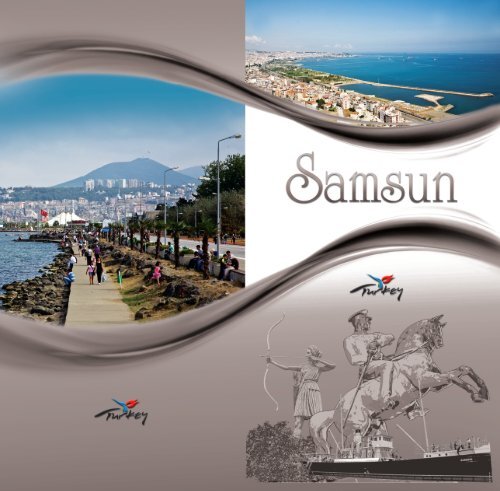
![11. Türk Arkeoloji ve Etnografya Dergisi [2011] - kulturvarliklari.gov.tr](https://img.yumpu.com/50970752/1/182x260/11-turk-arkeoloji-ve-etnografya-dergisi-2011-kulturvarliklarigovtr.jpg?quality=85)
